After what seems to have been an endless winter, the warm days can’t get here soon enough, and they’re finally right around the corner! And nothing can ruin your day faster than pulling back your pool cover to see a green, algae-filled pool. Hopefully this won’t happen to you this summer, but if it does, here’s what you’ll need to know about shocking your pool to remove algae.
First Steps to Clearing a Green Pool
Before you start pouring shock in the pool, the first step is to brush the sides and floor of your pool to loosen all the algae. Doing this breaks the skin and allows the pool shock to more easily kill the algae. Once you’ve done this, it is important to make sure you have the proper pH level in your water. The best pH level should be on the low side, between 7.2-7.4. A high pH level can prevent the chlorine shock from properly killing the algae. Be sure to test your pH before adjusting, with a fresh and reliable test strip or test kit.
In order to clear a pool suffering from a severe algae bloom, a chlorine level of about 30 ppm is preferable for optimal results. If you aren’t dealing with a full blown algae bloom, levels of 10-20 ppm can be effective.
Shock the Pool:
The best way to administer shock into your pool is by pouring it into a bucket of water with at least a couple gallons of water. Mix it to dissolve, and pour the mixture around the perimeter of the pool. And remember — always add shock to water, never add water to shock!
Now it’s time to wait a while. Keep your pump and filter running. Give the shock a good 12 to 24 hours to work its magic. If the algae hasn’t cleared up after 24-48 hours, clean and brush the pool and add another shock treatment.
When the chlorine has completely finished working, the algae in the pool will turn a white/gray color and will either settle to the bottom of the pool or be suspended in the water. There shouldn’t be any more green color and the water visibility should be improving. Run the filter 24/7 and backwash as needed.
Clean the Pool:
When the water begins to clear, it’s time to vacuum your pool to get rid of all the dead algae. You can use a flocculant to settle suspended debris or a clarifier to aid in filtering. It is best to vacuum the dead algae to waste. You don’t want to trap all the dead algae in your filter. That can create a recurring algae problem.
Once the debris is gone from the water, it’s time to brush again with a new or good condition pool brush. Make sure there is no residual algae left on the walls or floor. Brush vigorously! If you feel the pain in your shoulders and arms, you’re doing it right!
Clean the Filter:
After a thorough vacuuming and brushing, it is a good idea to clean your filter as well. If you have a DE or cartridge filter, remove the element and soak or spray with In The Swim Cartridge Filter Cleaner, and spray away all dirt and algae. Sand filters are a little more difficult to get clean. You can either replace the sand, or you can use a Sand Filter Cleaner. Natural Chemistry’s Filter Perfect does a great job on any filter type, using natural enzymes and citric acids.
Test and Balance the Water Chemistry:
Test and adjust your pool to these levels: Free chlorine: 2.0–4.0 ppm, pH: 7.4–7.6, Total Alkalinity: 80–120 ppm, and Calcium Hardness: 200–400 ppm. Proper water balance in your pool is crucial to keeping clean water and staying algae free.
Any time your pool drops below 1 ppm of free chlorine, you are in the danger zone for algae (not to mention bacteria and viruses), especially if your pH and alkalinity levels are off, too. When your chlorine level is not high enough, it fails to kill off organic compounds that aid in algae growth.
Algae feeds off of phosphates found in plants and almost all other things in our environment. When phosphates enter the water with chlorine below 1 ppm, you’re almost sure to have an algae bloom. Sometimes it can even happen in a matter of hours!
How to Prevent Algae:
Prevent algae with good water balance and constant chlorination. There are a lot of maintenance products out there to help safeguard against algae and keep it from ever being an issue. For extra algae prevention, use weekly maintenance doses of algaecide and Natural Chemistry’s PhosFree to eliminate an algae food source.
Algae is a lot easier to prevent than to remove, but once you have it, brush the pool, lower your pH with a pH reducer, and then Super Shock the pool. Vacuum and brush again, and clean the filter — that’s the most effective way to get your pool back to normal.

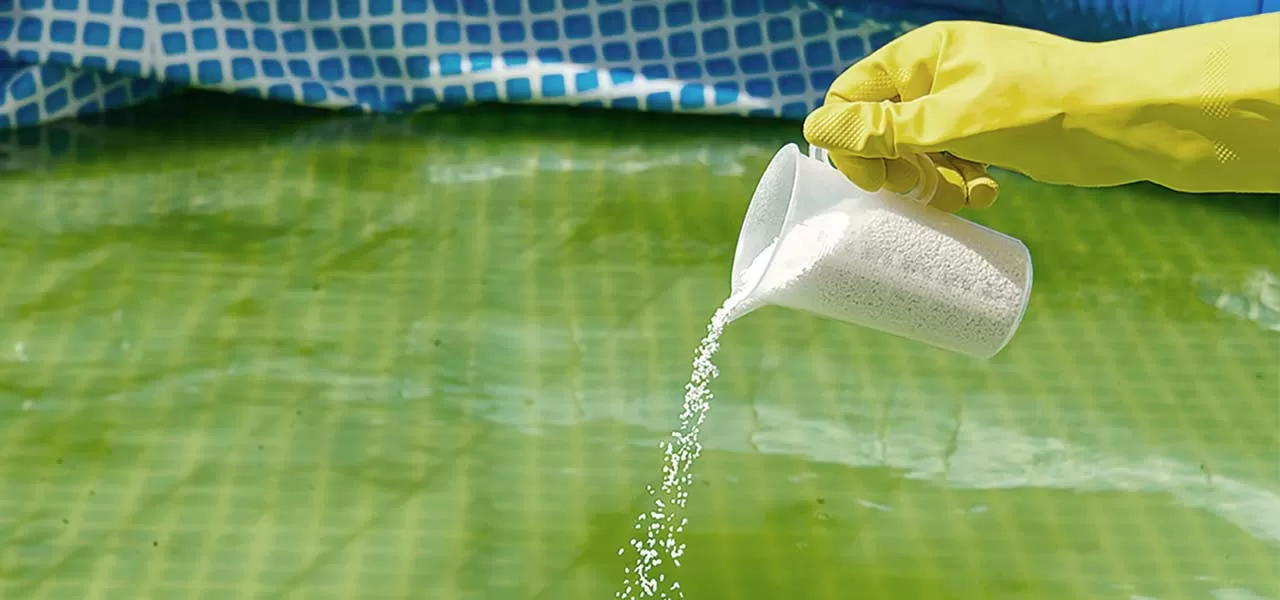

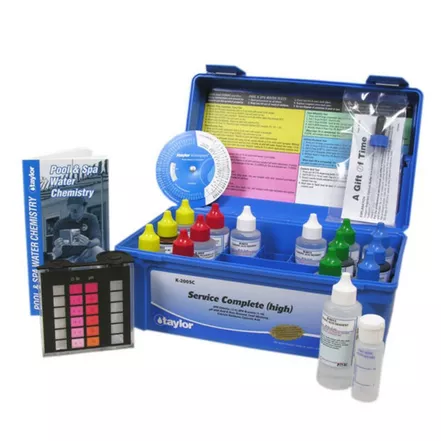


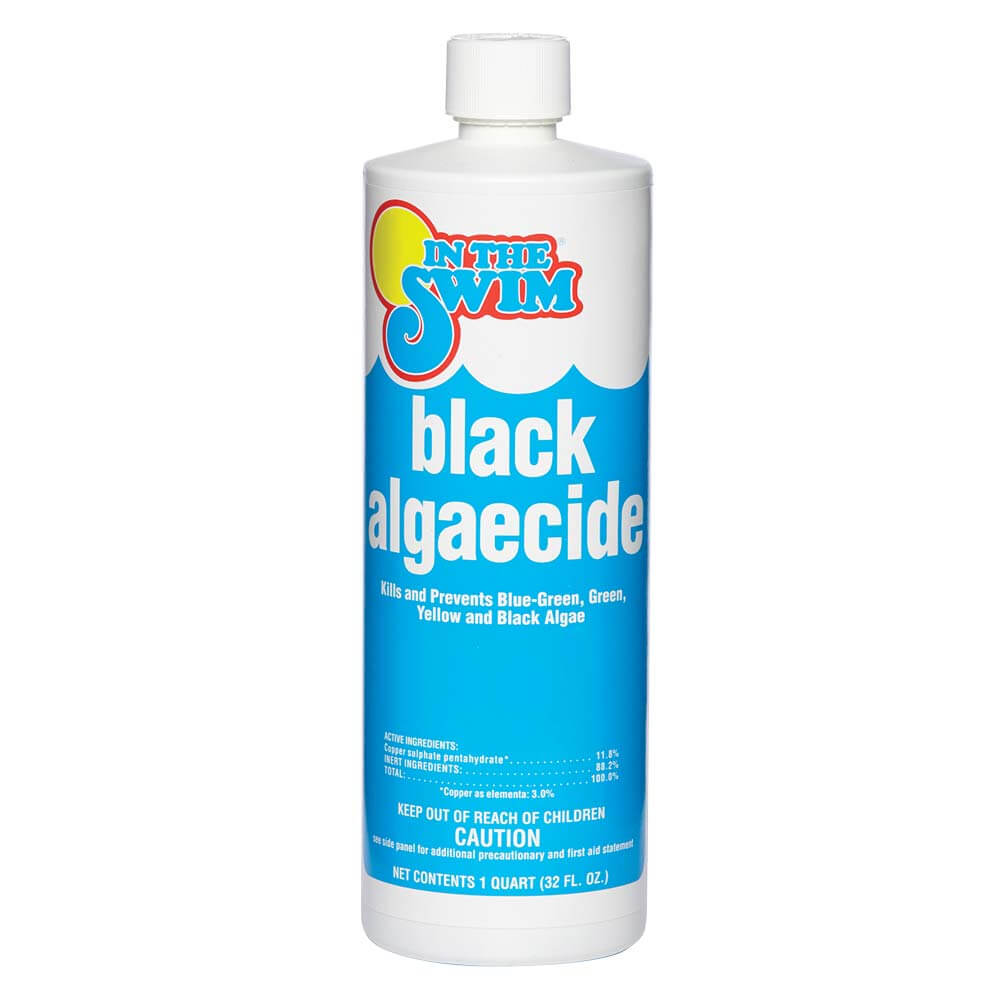
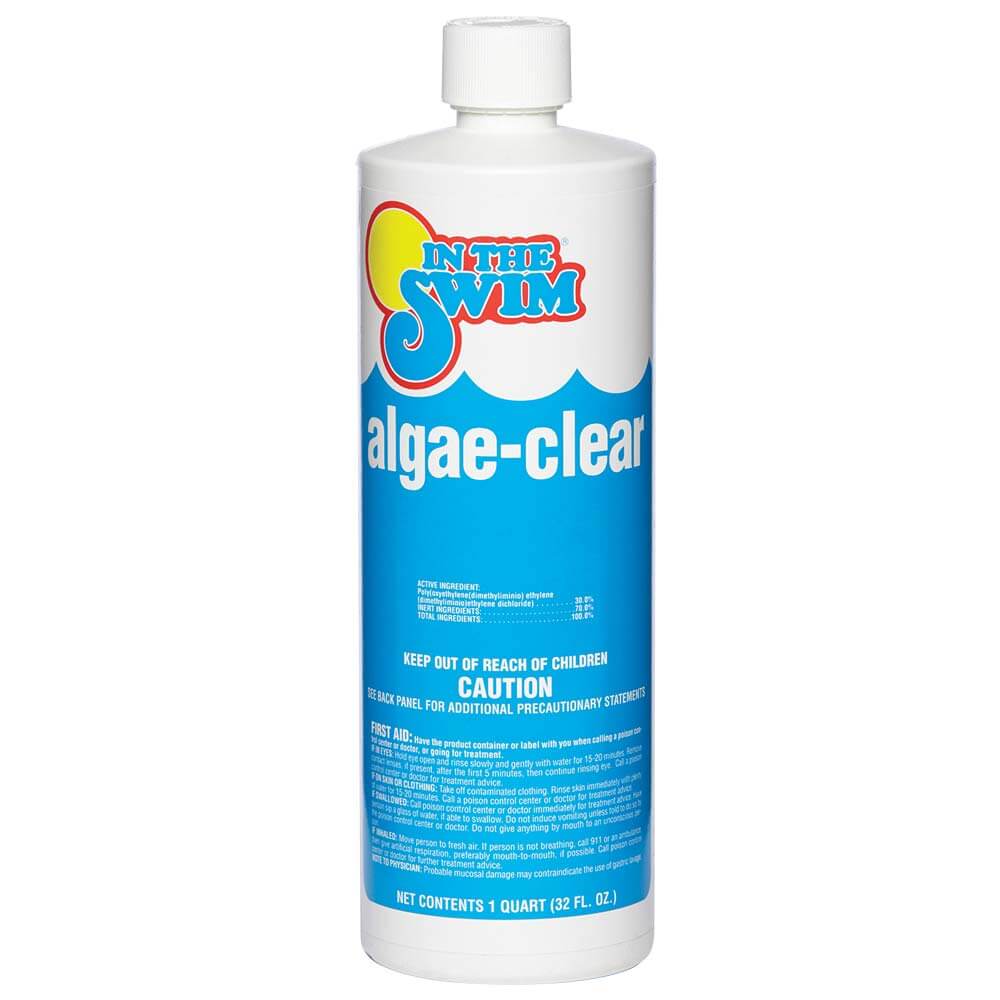
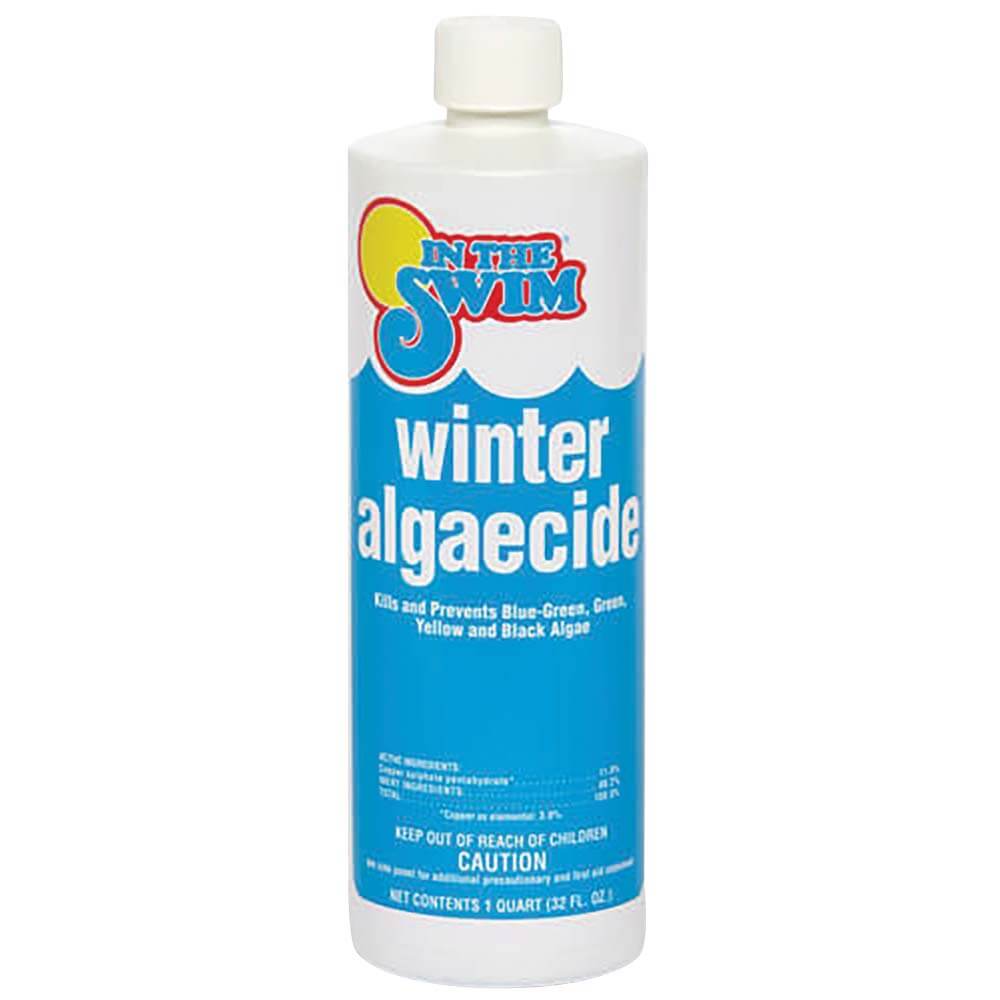
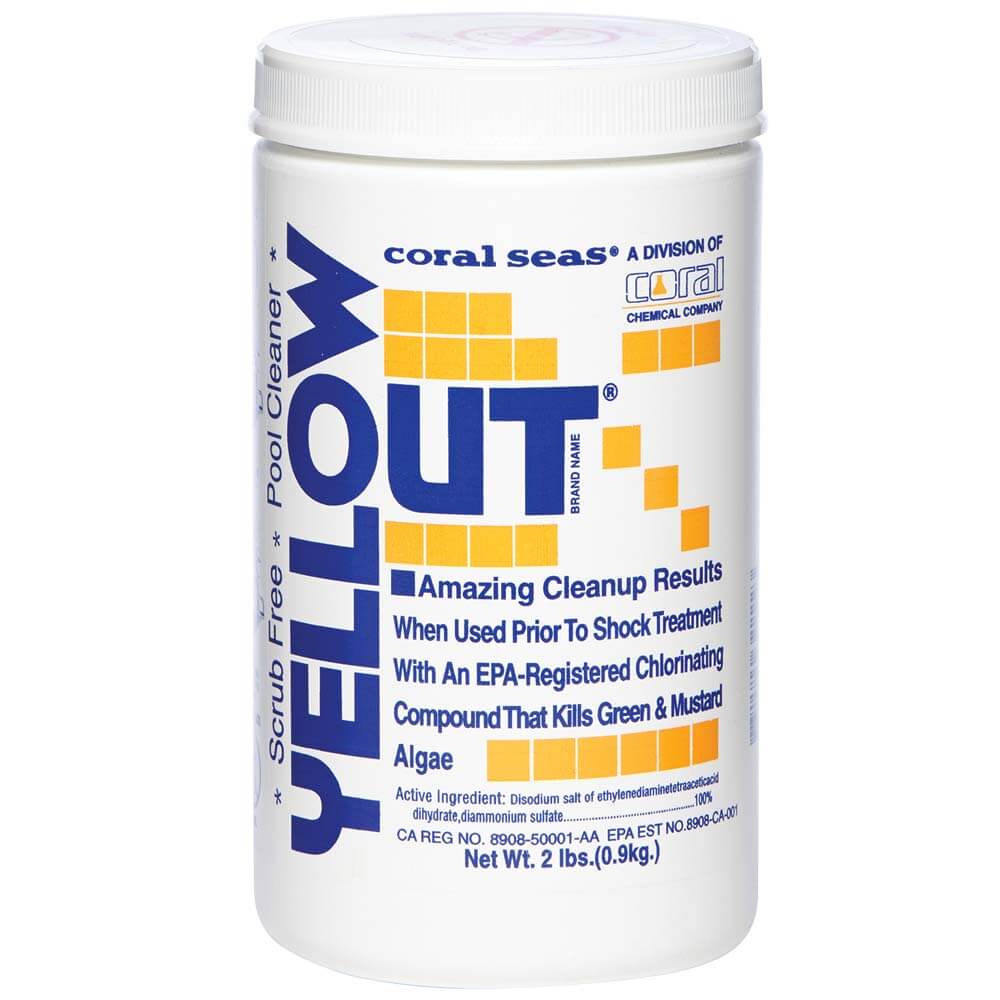
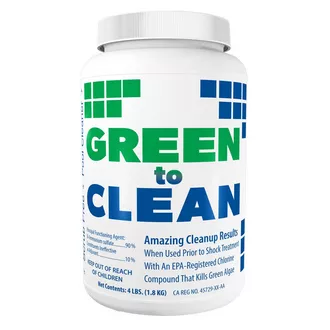
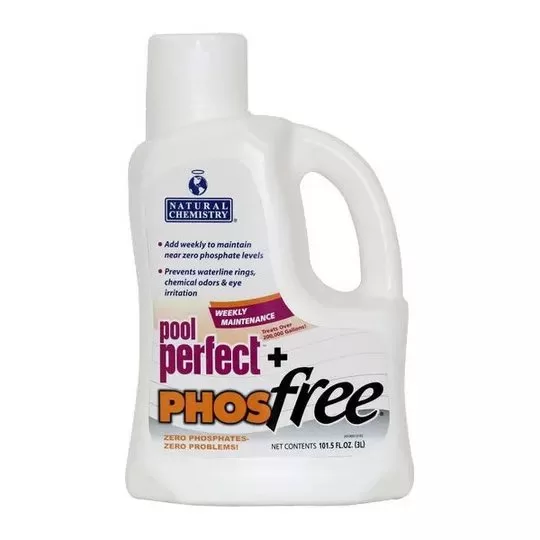

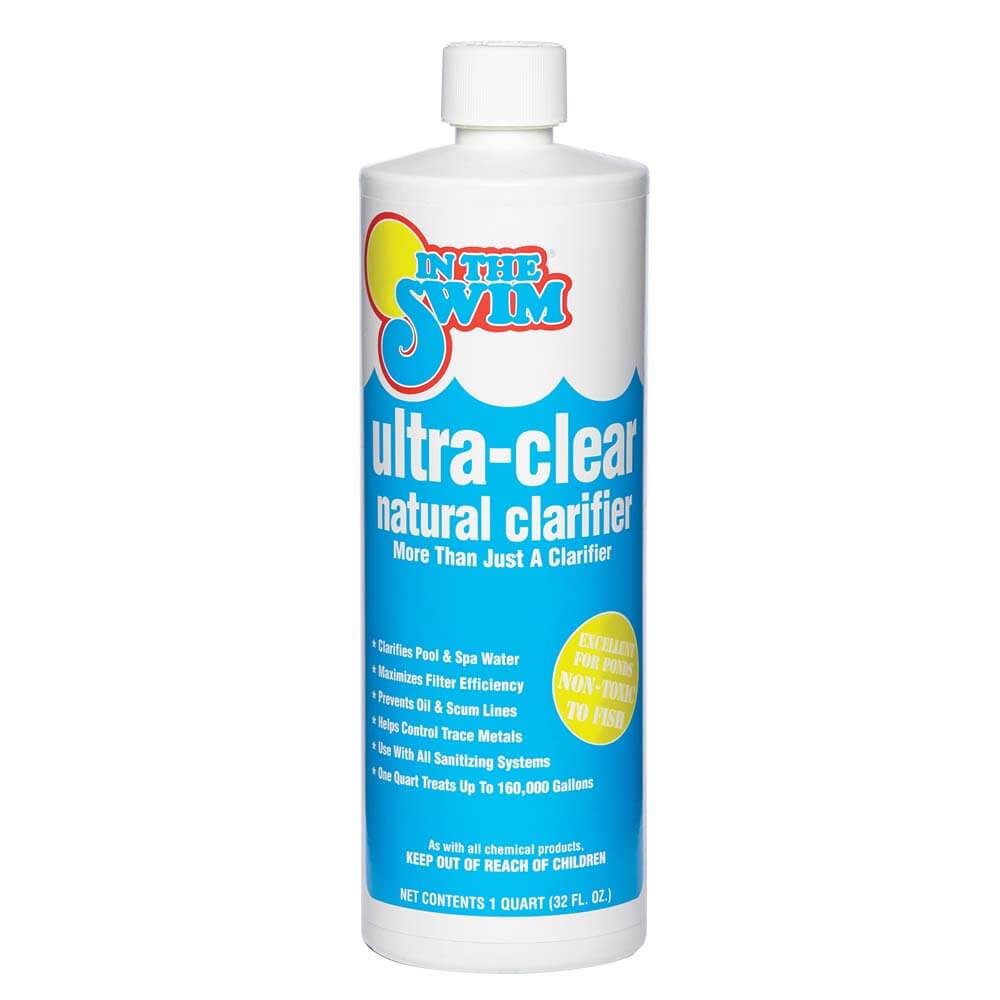
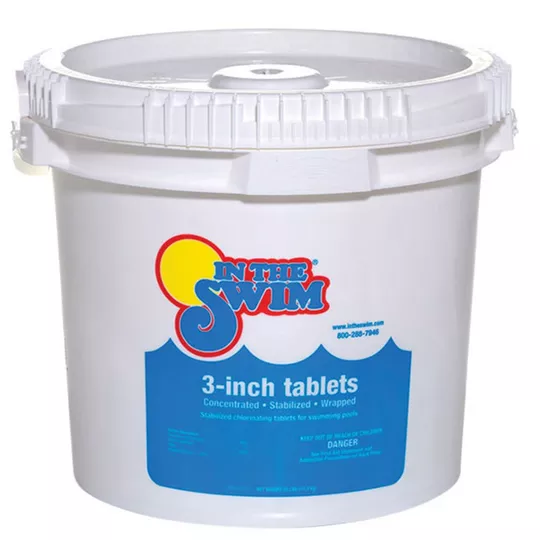
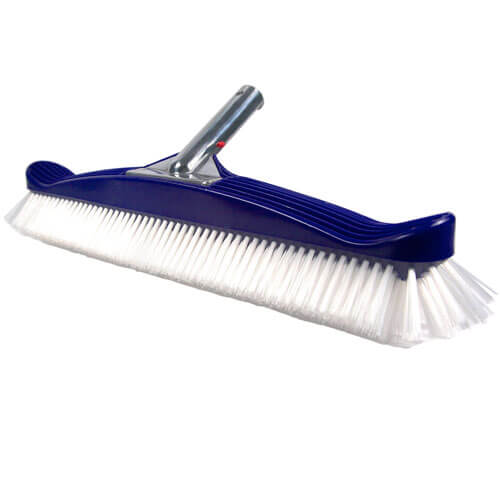
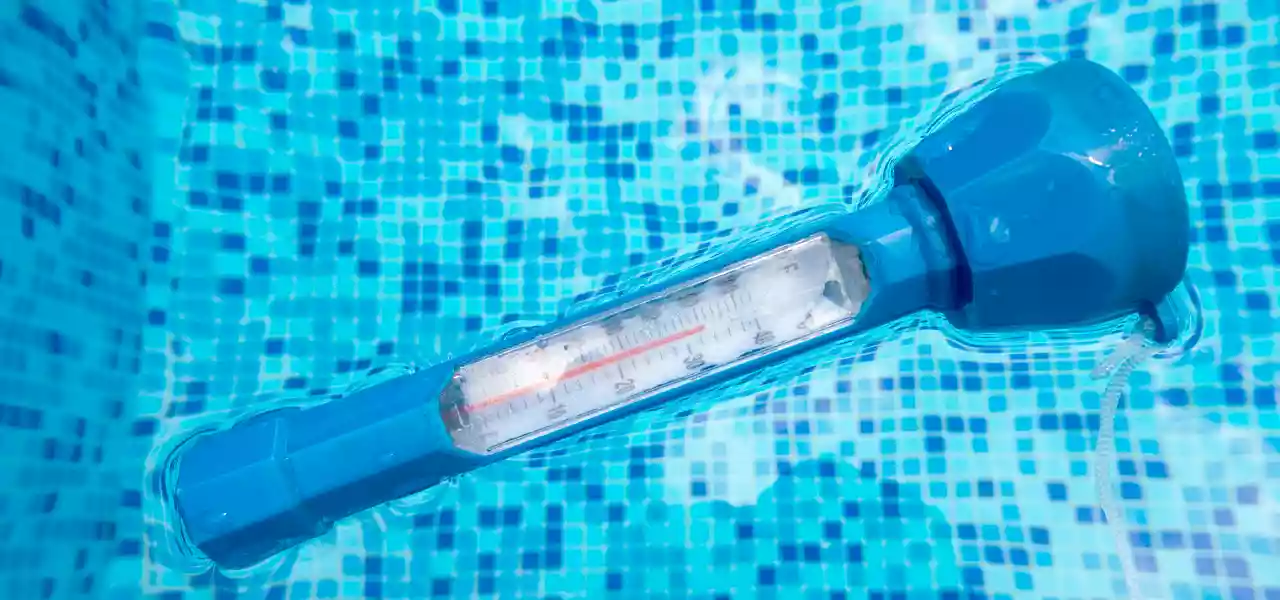

I have a 5,000 gallon metal frame pool. We just cannot get rid of this algae. The filter is not great. I checked the ph yesterday and it was good. I cleaned the filter brushed it all and added 1 lb of super shock. This morning there’s no improvement and the ph is really high. I added muriatic acid to lower the ph. How can I get rid of this algae?
Hi Amanda, keep a high chlorine and low pH levels and constant filtering, and you may have a chance. Clarifier may help the filter, but if it is not improving in a week or two, I would drain the pool, scrub it out with a bleach water, and refill, and replace the filter cartridge with new.
I have a 40,000gal in-ground vinyl with cartridge filter pool. Water was blue but cloudy. I used floc and all the grey dead algea dropped. But now that I’m vacuuming the filter that has been cleaned is not catching the algea, it gets pushed through the filtration system and is being pushed back into the pool making it cloudy again. What am I doing wrong?
After floccing the pool, you should vacuum to waste. Hard to do on a cartridge filter, there is no multiport valve. Being that the pool is so large, I think the best option is to install a 3-way valve between the pump and filter, and attach either a length of PVC pipe, or a length of backwash hose. Turn the valve when you want to vac to waste or lower the water level. A cheaper way to do the same thing is to install a Tee fitting and a 2-way valve, also between pump and filter. Keep a plug in the Tee normally, and remove the plug when you want to vacuum to waste, screwing in a short length of pipe or hose if needed. You can also place the waste line after the filter if needed, and just remove the pool filter, when vacuuming to waste. A (poolman) way to do when needed is to remove the filter cartridge, and leave the lid off of the filter. Cover the pump motor (not tightly, it needs air) with something so water won’t splash on it, along with other equipment, and make provisions for erosion if needed, and just let the filter overflow itself, and splash onto the ground.
I’ve shocked my pool (6lbs in a 30,000 gallon pool) and it appeared the algae died and fell to the bottom. I’ve manually vacuumed twice (to waste on a sand filter). But it seems right when I’m done vacuuming more algae falls to the bottom. I’ve added a full bottle of phosfree. Could it be that I just have to keep vacuuming to get all the dead algae out? Thanks!
Hi Eric, The Phosfree may be contributing to the fall-out, it is supposed to raise the filter pressure, requiring backwashing. But some of the silt may be passing thru the sand filter, which may indicate that it’s time to change the sand. Using a Clarifier now will help with the problem, and perhaps another vacuuming. It is normal that (some) very silty dirt passes through a sand filter, especially smaller size filters. There is a product called Slime Bag that is helpful, is a filter bag that attaches to the return line.
Hi, when treating a pool with algae you SHOULD run the filter and pump when super chlorinating the pool? In a bit of a debate with my dad
Hi Heather, absolutely run the pump to circulate the water, and continue filtration, after shocking. One of you may be concerned about the caustic nature of very high chlorine levels, but the pump, filter and even heaters are very resistant. Just be sure to remove any solar covers after shocking the pool.
Been getting serious rains he last two weeks, to the point the pool overflowed. Now I’m fighting green spots on the bottom of the liner. If I super shocked the pool over 10ppm, how long would it take to get back to swimming levels?
Hi Cat, only a day or two, 3-4 at the most – high chlorine levels normally drop rapidly, especially on sunny days.
My pool was bright blue all year and then one day it was milky white, I shocked it and it clear up some what, however, had a party with about 8 people in the pool and the next day it is back to milky white. I Used Floc, however, I vacuumed it back into the pool. Any suggestions
‘
Hi Joe, let the filter run 24/7 if not already. After flocking, you should vacuum to waste, if you can with a multiport valve. For now, keep the chlorine level high, with a good low pH level, then Add clarifier, and perhaps a filter cleaner if you suspect the filter media is clogged up.
We bought a used solar cover. We used it once. Since then (2 weeks ago) we have been fight algae like no other. All of our readings are good other than free chlorine. No matter what I do I can not get it up or clear the algae. HELP! Our pool is a 24’above ground approximately 15,000 gallon. Sand filter. After I used an algaecide and flocid I vacuumed on the waste setting. When doing this it took out so much water it was about 10 inches below the skimmer. The water looked fairly clear at that point. Feom there I checked levels and added chemicals till they were where they should be…still couldn’t get fcl above 0. Went on a camping trip over night (pump wasn’t running, pool was a cloudy teal… chemical levels still good other than fcl…now cloudy green…help.
Hi Tomi, sounds like the pool is contaminated with phosphates, nitrates or some other invisible enemy that is consuming your free chlorine. You can test for phosphates, and if over 300 ppb, you can remove them with a phosphate remover like PhosFree. Another route is to shock the *&^%$ out of the pool, with a triple or quadruple shock treatment (3 or 4 lbs of shock per 10000 gals), which usually has the effect of destroying all molecular combinations in the water – fully disinfecting. Also, in times like these, be sure to run the filter longer each day, 24/7 if possible.
I am new to pool ownership. I have managed to keep the chemicasl at their appropriate levels and managed to get the water clear, but I have a thin layer of something on the bottom of my pool that isn’t close to the filter. I can’t seem to vacuum it up. When I try it just blooms up in the water. I don’t know if I should use floc or if I should super shock it. I hope you’ll be able to give me some advice. Thank you.
Hi Deanna, a clarifier might be of some help, but not floc or shock. You have a sand filter I presume? A Slime Bag is a product that can help sand filters perform better. Sounds like your vacuum suction is very poor, or you need to move the vacuum head very very slowly to capture the fluffy stuff. Probably some pollen dirt mixture.
hi, i have an above ground pool 18’x52″. it is a Pro-Series pop up pool metal frame with vinyl siding.
my pool was not closed properly, my son forgot to put the closing kit into the pool. so we put the cover on and it wasnt too bad of a winter here in NY, however we took the cover off and the pool is green. i can still see the bottom so im assuming it it not too bad.
i have gotten an array of advice to draining to using bleach. im sure its going to be some work, im wondering without over working the pump which isnt the greatest btw, would the best course be to drain it and scrub the sides refill and then retreat?
please advise.
thank you Dot
Hi Dot, I’m a fan of draining and refilling, in such cases where a small pump/filter is involved – plus pool water gets choked with solids over time, and pool chemistry is easier to manage with fresh pool water. Plus, water is cheaper than chemicals, you can refill your pool for about $20 in water cost (in most areas). Rent or borrow a small submersible pump, drain it overnight, hose it down and use a push broom or pool brush on the floor and walls. Tip: don’t let the green stuff bake-on the walls in the sun – brush the walls before draining, and/or spray with a garden hose every few hours while draining, to remove any dirt and algae from the walls.
[…] algae colony or remove organic stains on concrete pools. In larger doses, pool shock will restore green pools, break apart chloramine bonds, and kill […]
[…] by running the pump 24 hrs per day for several days before a No Drain Acid Wash. Additionally, shocking the pool heavily to remove organics and establish a high chlorine residual, can help avoid cloudy water or […]
I am new to pool ownership. This is my first summer tuning it. I have a vinyl liner and have kept my chemicals perfect all summer (chlorine, Ph, and alkalinity), but it has been raining nearly nonstop for almost 2 weeks so algae got ahold of my pool. I shocked the pool 20k gal pool with 4lbs of shock with no change so I added 2 more lbs and that knocked it out. My Ph went from high reading to 7.2, chlorine is a 2, and alkalinity is 80. My pool is clear now, but cloudy. I’m waiting until morning to decide how it looks and what I may need to do next. Should I mess with the alkalinity and add 5lbs to bring it up a bit? I’ve never used clarifier, but it seems that might get rid of the milky/gray look to the water. Thanks!
Hi Sarah, the low pH level is good for shocking the pool, chlorine is much more active at a low pH level. Alkalinity is OK at 80 ppm. Clarifier is a good final step after shocking, after the chlorine level drops back down a bit, especially useful for pool filters that are super effective.
Hi! Thank you for this advice and good information. We have a 25,000 gallon chlorine pool and I use a floating solar copper ionizer to help keep the algae at bay. I have a few random black dots on the bottom of my pool and on the steps on the opposite side. I can’t figure out if it is from the drops of copper that drained out and stained the pool or if it’s black algae. I have brushed, added 5-6 bags of shock, whole container of algaecide and run the pool for 36 hours straight. They’re still there.
Hi Abbey, it could be a part of the ionizer cell that fell apart, does it look kind of blue/green oxidized and flaky underneath the ionizer? That would likely be a copper sulfate, which could appear black. Black Algae, on the other hand, has a pronounced head that is slimy and raised 1/8″ or less. The heads can be scraped off with a butter knife or with a pool chlorine tablet. If there is no round slimy head, I don’t think its algae (you may have to inspect closely, with a mask or goggles). Sorry for all the chemical cost if so – for a metal stain, you can use a lb. of pH decreaser (or EZ Stain remover) in an old orphan sock (finally a use for those!), tie it off tight and cut off the excess. Use your pool brush to position over the stain for 30-60 seconds, and move around with brush, or get in there and scrub it with the stain sock. A Jandy Stain Master can also be used to deliver liquid acid directly to the source. If your entire pool has an overall staining however, trying to remove these small dots could produce the opposite stain, where now you have larger white dots on the pool 🙂 So, proceed slowly. Scrubbing with a pumice stone or PoolStone is also an option.
My mother in law has a pool and refuses to let us wear the same swimsuits in the pool that we wear to the lake for fear of algae. Even if I wash them she’s still afraid they’ll contaminate the pool. After several years of hearing this I’m determined to prove her wrong. What’s your professional opinion? Is there any documentation or known occurrences of this being an issue?
I’m just tired of having two sets of swimsuits for every member of my family.
Hi Angie, you think you’re going to win a fight with your mother in law! lol – but seriously, there may be some merit to her claim. Pools and lakes are very different and what may be a beneficial algae and bacteria in the lake, can be very much a problem in pools. So I have to say it’s probably a good idea, to use two suits (sorry).
Other chemical company recommends higher PH of 7.8-8 when fighting algae that is established. You are indicating lower than normal.
which is it or should one try both extremes to see which throws the algae out of its comfort zone?
Hi Phil, if you are fighting algae with Chlorine, you definitely want the pH to be on the low end of the scale for better chlorine efficacy and potency. If you are using a chemical which specifically states on the bottle to raise the pH to 7.8 or 8.0 for example, then follow that advice. Algae prefers high pH levels, so in most cases that I am aware, a lower pH will yield better results.
Green slime, walls and bottom scrubbed, PH7, algaecide, and heavy shock on 15x30x4 above ground. 16 hours and no change, worried, miracle or new water?
Hi Sue, probably not enough shock added – keep adding until the water turns a blue/grey color. Could take double what you added. You’ll know if you add enough, when the water is still blue the following morning, and there is still a testable chlorine reading in the water. If it looks greenish and zero chlorine – you missed the mark 🙁 – try again. Also, shock will break apart algaecides, and algaecide doesn’t kill algae very well anyway (prevents). Raise the pH slightly to 7.2-ish, and shock the pool with 3, 5, 7 (?) lbs of shock, pre-dissolved into a bucket of water – keep adding until the color changes. You can also supplement granular shock with several (3-5) gallons of unscented bleach, if you want, added separately. Run the filter non-stop, and clean when pressure gauge rises and flow rate slows. After shock chlorine level drops, usually after a day or two, add clarifier to help the filter, and begin using algaecide. And keep the chlorine high with tablets. Draining a portion of the pool (up to half) and refilling, can also help reduce the solids level in the pool, and help the filter clean the pool faster, if that is possible for you. Also be sure the cyanuric acid level is 20-50 ppm, stabilizer to protect chlorine from the sun.
Hello,
I have a 20-year-old , 15,000 gallon pool with a LEGENDARY 1.5 HP DuraGlas PUMP, a 100 sq ft Posi – FLO FILTER and a Master Pools Turbo Clean infloor cleaning system. The inlet pipe to the pump is 2″ , and the pump outlet and filter inlet and outlet pipes are 1 1/2″ . I know there’s a tiny, hairline crack in the pump lid, which is probably introducing some air into the suction side, BUT the pump primes itself fairly rapidly (although the water seems to be about halfway down the pump pot basket when it’s started each morning), there is decent pressure though the water returns, and there’s good suction in the port below the skimmer basket. As such, I THINK the pump is performing at least adequately. Do you have anything ( e.g. two part epoxy) that repairs lid cracks??
The FILTER is working, at least partially, as the FILTER element has been accumulating some green algae. There’s also debris in the pump basket strainer.
Even though I run the pump 10+ hours a day, keep the water chemicals balanced ,and constantly Clean the FILTER element, pump and skimmer baskets, I’m STILL having algae issues; which is VERY FRUSTRATING!!!!
I added fifteen (15) gallons of chlorine – A LOT of chlorine for a Pool that size – the other night and have been running the pump ever since , BUT the algae STILL hasn’t cleared. I performed the OCLT test yesterday, And the chlorine level stayed about the same, SO I THINK that’s a GOOD sign. Correct me if I’m mistaken, BUT I believe that even if there were poor circulation, 15 gallons of chlorine should still do a number on the algae, especially since I distributed the chlorine evenly around the pool. Perhaps the 100 sq ft filter just can’t remove the algae growth fast enough?? Any info you can provide would be appreciated. Thanks.
Hi Charlie, thanks for the detail. For the pump lid crack, you can use a number of sealants, but a clear silicone gel would likely be best, first clean the lid very well, inside and out, using soap and scrub sponge to remove oils and dirt. Then apply a bead of superglue into the larger part of the crack, let dry 20 mins. Reinstall the lid, start the pump and then apply a bead of clear silicone on the outside, and smooth with a putty knife somewhat. Leave the pump running for at least 8 hours or until full cure.
For the algae issue, I would test the pool for phosphates, we have a AquaChek phosphate tester, or just treat with PhosFree. If you have not replaced the filter cartridge in many years, doing so may yield good results. Algae can harbor deep in the pleats of cartridges. 100 sq ft filter is OK, not great for your pool size, I normally like to see a little larger, so it may be overwhelmed at times. Using an algaecide regularly can help pools that seem prone to algae, but never add shock and algaecide together, the shock will kill (render useless) most types of pool algaecides, which are better used for preventing, not killing algae.
For pools with algae struggles for years, with annual blooms for 5+ years, and getting worse each year, a radical treatment is to drain the pool and pressure wash, chlorine wash (or acid wash) (a concrete pool), replace the filters, nets, brushes and other soft surface items that have any potential algae spores, refill and start over. A larger filter wouldn’t hurt either, 200 sq ft, in your case.
I’ll bet your cynauric acid level is high.Had the same issue you need to drain pool water to get it to about 40-50 , mine was at 210. Do some research I guarantee that’s your problem. I was so Pissed nobody ever told me about. Faught it for 2 years
Hey – I am hoping you can help. I have had my pool for five years and have been using Pristine Blue. I have never had any trouble. For the first time – this year at pool opening, I had Algae. I cleaned and shocked it. My pool changed to a pretty blue color (clear as drinking water when I pull out a sample), but I can not see the bottom. The pool store told me that I killed it, but it is still floating in the pool. I have followed all of my pool store instructions – for three weeks I have run the filter 24/7 (except when I used flock – I still could never see the floor of my pool) – I have brushed the pool – used the vacuum – backwashed the filter regularly – and I have used all the shock and chemicals that I purchased for the summer.
Not many people in my area are familiar with Pristine Blue – the nearest dealer is two hours away – so having someone come out and look at the pool isn’t really an option.
I am wiling to change over to a chlorine-based maintenance if necessary, but I am not for sure how to transfer from copper based to chlorine based.
I would really just like to use the pool sometime this summer. Any suggestions?
I think to convert, you don’t need to do much, just start using chlorine tablets, in a floater or better in a chlorinator, and stop adding the Pristine blue. I would add a stain & scale chemical regularly, to keep the copper dissolved.
So I had algae last year towards end of season got rid of it. Open the pool and was fine now all of a sudden it’s back. I’ve shock pool and vacuumed several times and still here. Filter was cleaned Getting so frustrated. Please help
Hi Jason, algae can be like that – it harbors until conditions are right to bloom again. Be sure that your pH and alkalinity levels are in range, chlorine works poorly in high pH conditions. Filter was cleaned? Algae can survive deep in the filter tank. If possible, replace your filter sand or filter cartridge (if you have DE filter, remove and soak entire grid assembly in a trash can with 1 gallon bleach to 20 gallons of water, remove and dunk in pool, or rinse well with hose). Also be confident that you are running the filter long enough each day, you may need more hours. Finally, you can buy some phosphate test strips, and test your water for phosphates, a yummy food for algae. If over 300 ppb, treat the pool with a phosphate remover. If you have shocked the pool but the algae persists, check that pH is kinda low 7.1-7.3, and then add a triple shock treatment (3x normal dose). If that doesn’t kill it, try a 5x shock (5 lb per 10K gallons). good luck!
We have an 18 round pool with a sand filter we added 3 bags of shocker and a half bottle of algaecide and 2 tablet in the floater and.my pool is still green I told my husband to brush the sides and bottom of the pool and he said there’s no need to do that
Hi Lori, well I hate to get in between you and your husband, but I would brush the pool, yeah. Also I would check the pH, make sure it’s 7.2-7.4, and then shock the pool again, 3-5 lbs or until it turns a blue grey color. Run your filter 24/7, and skim, vacuum and brush daily. Backwash when pressure gauges rises 7-9 lbs higher than clean pressure.
Hi! We are new to caring for a pool. So upon opening our 18×48 above ground pool this is what we have done, cleaned out biggest part of leaves & larger debris. then got the pump & filter up & running. Added 128 oz of liquid shock & left for a little over 24h. Then we vacuumed the pool. My husband left the filter setting on filter instead of waste or backwash without thinking. Part way thru vacuuming the water went from clear to milky to where we could not see the bottom any longer. so he finished the best he could. The next day the pool was still milky & discolored with all the yuck from the water setting all winter long still visible somewhat. We added another 128 oz of shock & have left it filtering for several days & no improvement. We then added 16oz of clarifier & have left filtering for 2 more days. We can see the bottom somewhat now but the water is still far from clear. Can you please help us to know what we need to possibly do. Again I can not express how little we really understand about it all. Thanks!
Hi – sounds like you do know what youre doing, you’re just waiting for the water to clear. You didn’t mention pH and alkalinity, so I’ll ask about that, best to be in the 7.2-7.4 range. Otherwise, just let the filter run all day and night if possible, and backwash it only when needed. It will clear eventually. You can do another clarifier treatment, after 5-7 days from the first, but be careful not to overdose, only what the label says. Keep the chlorine level reading at 2-3 ppm, by checking it daily and adding chlorine tablets to a floater. Shock again if you see algae forming. Check pH at least once per week – it’ll come back, but with a small filter, it can take some time… 🙁
I treated my green pool with shock and brushed before hand. Then when the pool started to clean up a little I brushed again and now it is green again. Do i need to reshock the pool or just let the filter run it’s course? I have a cartridge filter and clean them every day. Secondly I have a variable speed pump, is it better to run at high speed for turnover till clean or lower speeds to filter better?
Hi – check the water chemistry, if you have a good solid level of chlorine, and good pH level, then let it ride. If your chlorine level is close to zero, and you see traces of green algae, probably best to shock again. I would also run the pump on high, until you get clean and clear water again. Cartridges should not need to be cleaned daily, but maybe, if the filter is very small, or the cartridges are very old.
I need to run that bad algae thru my filter when u put shock in ? I was thinking I needed to backwash on waste using m leaf net to get leaves out left over. Its not many now but I need to know it’s ok to run all that ukky thick algae thru my filter
Hi Doris – Yes, you can run it through the filter, depending on the size of your filter it will clog up sooner or later, but eventually will need cleaning. You can vacuum to waste if you have multiport valve, that is a good idea, but running the filter is important to remove the dead algae from the water. Keep an eye on the filter pressure and water flow rate, and clean or backwash the filter as needed to maintain both